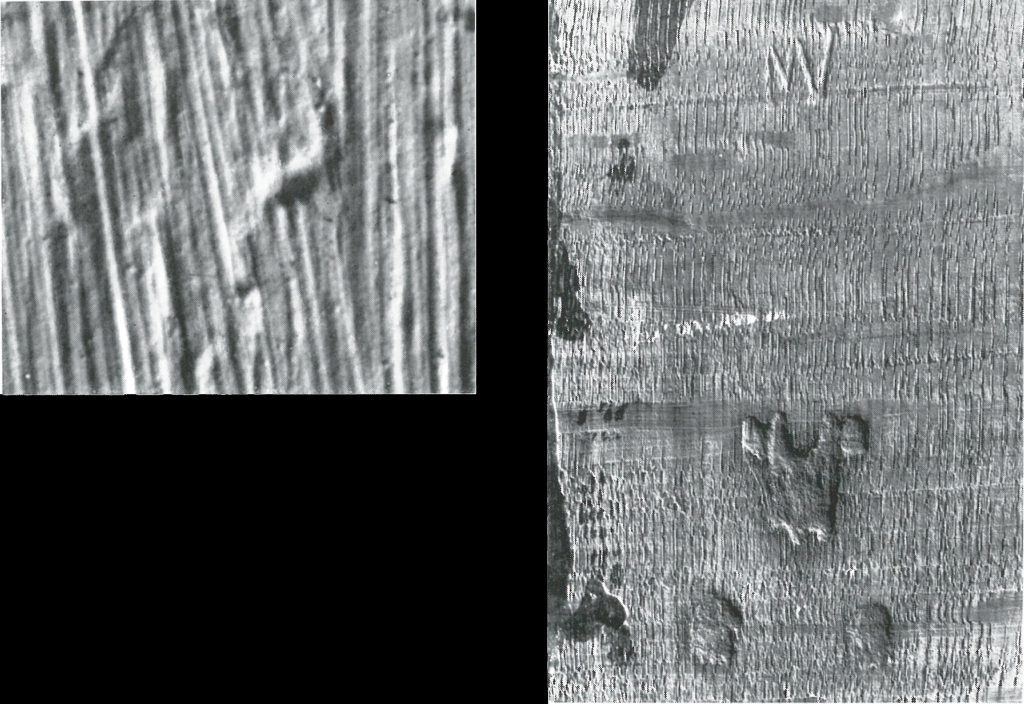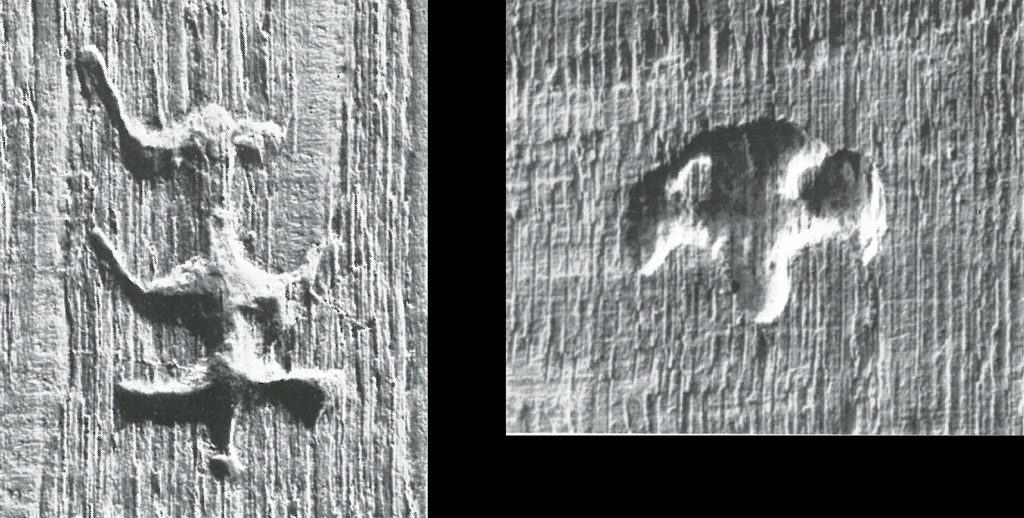G. Gepts ‘The Panel maker Michiel Vriendt, supplier to Rubens’ originally published in Jaarboek Koninklijk Museum voor Schone Kunsten, Antwerp, 1954-1960, pp. 83-7 as ’Tafereelmaker Michiel Vriendt, leverancier van Rubens’.
Translated by Michael Lomax, 2021
© Jordaens Van Dyck Panel Paintings Project.
How to cite: Gepts, G. “The Panel maker Michiel Vriendt, supplier to Rubens” In Jordaens Van Dyck Panel Paintings Project. Edited by Justin Davies, translated by Michael Lomax
http://jordaensvandyck.org/article/the-panel-maker-michiel-vriendt-supplier-to-rubens-gepts/ (accessed 3 December 2025)
G. Gepts
Examination of the reverse sides of the panel paintings from the Old Masters collection of the Antwerp Royal Museum of Fine Arts has revealed marks on several panels, to which scant attention has been paid until now. These marks, in the form of stylized floral motifs and of monograms, were either branded or incised into the panels. On certain panels of Antwerp origin, a coat of arms of the city is also branded, consisting of a three-turreted castle under two spread hands.
The number of panels on which a coat of arms or mark could be found is small. However, only in a few instances has the reverse side of the panels been conserved in its original state. In order to prolong the lives of panel paintings, the restorer is frequently forced to treat the reverse: it is covered with wax or paint, thinned and glued to a new panel, or planed back and cradled. We can assume that a large number of marks have been lost in this manner. Thus, in the Antwerp museum collection, on small and medium-sized panels (the large altarpieces were not examined), just eight marks were found. The panels in question are:
No. 193. Master of the Female Half-Figures (probably Brussels, second quarter of the 16th century), Virgin and Child. Under the paint layer with which the reverse is presently painted, a very unclear mark appears to exist in the upper left half.
No. 869. Pieter Balten (died c. 1598, Flemish School). Ecce homo. Exhibits a cloverleaf, under the added paint layer (fig. 1)
No. 643. Jan ‘Velvet’ Brueghel (1568-1625, Flemish School). Flowers in a Vase. Under the added wax layer are the incised monogram MV and the Antwerp coat of arms. Visible until early 1958, these are now concealed.
No. 706. P. Rubens (1588-1640). Gaspar Gevartius. Produced in Antwerp around 1628. Exhibits on the reverse the monogram MV and the Antwerp coat of arms, still clearly visible under the recently added layer of wax. (fig. 2)

No. 731. Hendrik van Anthonissen (c. 1605 – between 1655 and 1660. Dutch School). At the Entrance of the Harbour. Exhibits on the reverse a plant-like motif with a long stem (fig. 3).
No. 104. Cornelis De Vos (1585-1651, Flemish School). Abraham Grapheus. Dated 1620. Exhibits on the reverse a fan-shaped plant-like motif, and two spread hands without the castle of the Antwerp coat of arms (fig. 4). [Editorial note: it is the Castle of the Antwerp brand of the Guild of St Luke.]
No. 345. David Teniers the Younger (1610-1690, Flemish School). Tavern Scene. Exhibits on the Reverse the monogram B.N.D. (fig. 5).
No. 731. Joos van Craesbeeck (c. 1601 – between 1654 and 1662). (Flemish School). Quarrel in a Tavern. Exhibits on the reverse the monogram M.V. and the Antwerp coat of arms (illustr. 6).
In other collections, attention was already paid at an earlier date to the reverse of panels. The 1928 catalogue of the Wallace Collection in London1 mentions marks on two paintings by Rubens:
No. 50. P. Rubens. Isabella Brandt. Executed around 1615-1620. Exhibits on the reverse the monogram MV (or MW according to the catalogue, p. 258), plus two hands and a castle with three turrets and a horseshoe-shaped gate in the centre.
No. 520. P. Rubens. Defeat and Death of Maxentius. Painted in 1621-1622. Exhibits on the reverse the monogram MV (or MW according to the catalogue, p. 263), similar to the one on no. 30, plus the branded number 8 and the letter A.

When the National Gallery of Art in Washington acquired the Rubens sketch The Meeting of Abraham and Melchizedek, the Antwerp museum received an impress copy of the MV monogram and the complete Antwerp coat of arms placed on the reverse of the panel.
The presence of the Antwerp coat of arms on the above-mentioned paintings produced by Antwerp painters in Antwerp should in all likelihood be interpreted as a warranty of the St Luke’s Guild for the quality of the delivered material. An equivalent of this practice existed already in the 15th century, when the regents or masters of the St Luke’s Guild demanded that carved altarpieces carry a hand or the complete Antwerp coat of arms with the castle, depending on whether the altarpiece was simply carved or carved and polychromed (painted).2
With altarpieces no longer carved, the use of the branded coat of arms appears to have continued sporadically. The panel-maker (tafereelmaker), the craftsman who supplied panels to the painters for their paintings, appears to have voluntarily subjected himself to the old inspection and approval custom.

The stamps that appear on the reverse of various panels have undoubtedly been placed by the woodworker or panel-maker himself. When, as on the painting by Pieter Balten and the one of Cornelis De Vos, a plant-like motif appears, it is difficult to retrace the maker’s identity. When, however, the panel-maker uses his own monogram, an identification is not excluded.
On the paintings examined to date the monogram MV appears six times, and each time in the first half of the 17th century. In going through the Liggeren3 [the official records of the St Luke’s Guild], there appears, precisely in this period, the name of one panel-maker, which corresponds to the monogram MV: Michiel Vriendt. He is first recorded in 1605 as an apprentice to panel-maker Robijn Pulinck. In 1615 he is mentioned as a master, and in 1617/18, 1619/20 and in 1633/34 he takes apprentices into his service. Michiel Vriendt died already in 1636/37, because in that year his death dues are registered in the Liggeren.4
The fact that Rubens made use of him for delivering the wood for his paintings is also proved by the accounts of the Onze-Lieve-Vrouwkerk.5
In 1624/25, “Michiel Vriendt” was paid for enlarging the panel intended for Rubens’ painting above the high altar in the Onze-Lieve-Vrouwkerk in Antwerp.
Examination of the reverses of old panels is not of direct importance for the knowledge of painting. However, in certain uncertain cases its can be of potential assistance in determining the date and provenance of a painting.
1. Wallace collection catalogues. Pictures and drawings. Text with historical notes and illustrations. London 1928.
2. J.B. Van der Straelen, Jaerboek der vermaerde en kunstryke Gilde van Sint Lucas binnen de stad Antwerpen, 1855, p. 15.
3. Ph. Rombouts en Th. Lerius, De Liggeren en anders historische archieven der Antwerpsche Sint Lucasgilde, 2 vols., Antwerp 1872.
4. Idem, vol. I, pp. 434, 514, 521, 544, 559; vol. II, pp. 54, 89.
5. Idem, vol. I, p. 403.